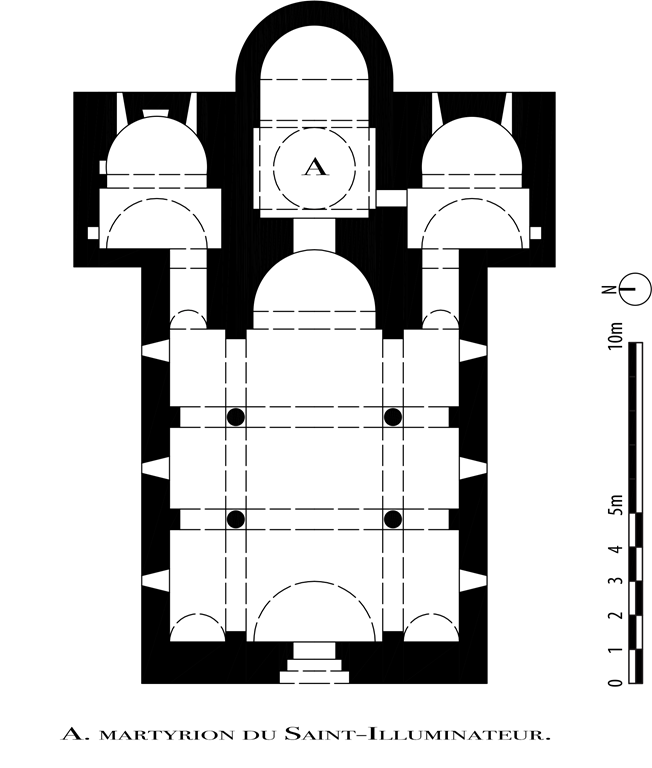The Monastery of the Holy Illuminator or, more precisely, of Saint Gregory the Illuminator (Surp Krikor Lussavorchi Vank‘ ) [Çankılvankı], was built at an altitude of 2600 m at the foot of Mount Sebuh [Kara Dağ-Köhnem], at 39° 43’ N and 39° 11’ E, on a south-facing ridge emerging from the foothills of the mountain, above the spur known as Drtadapert or “castle of Dertad (Drtad)” [Durnakale]. The monastery can be reached, among others, via the valley of Dzaghgamark [***], a route taken by the pilgrims coming directly from Erznga [Erzincan], through the mountains, after having stopped at the monastery of Gabossivank‘ (n° 46).
Like the Great Abbey or Avak Vank‘ (n° 44), the Monastery or Desert of the Holy Illuminator attests to the presence, in the canton of Taranaghi, in particular on the upper slopes of Mount Sebuh, at the beginning of the 4th century, of Saint Gregory – “the Illuminator” of Armenia”, and more precisely to his withdrawal to the vicinity of the grotto of Mane (Manéayr), named after a virgin who led a life of asceticism there. The grotto in fact consists of a series of caves dug into a steep rock face to the east of and above the monastery. Tradition also relates the passage of Saint Hripsime, whose martyrdom accompanied the predication of Saint Gregory. The monastery was built around an earlier martyrium likely erected in the 5th or 6th century over a first tomb of the Illuminator after his remains had been discovered nearby by a certain Karnig. For this reason it was also known as the Karnig Convent. Two side chapels were added later. In the first decades of the 10th century, during a retreat on Mount Sebuh, Catholicos John V (Hovhannès, 899-931) had a small church built between the caves and the martyrium, below and to the northeast of the latter. The church, which was given the name Holy Savior (Aménap‘rguitch), stood a few paces from the Pareham spring, whose appearance is attributed to Saint Gregory. In the 10th-11th centuries, a basilica with three naves and three bays was added, thus extending and enlarging the martyrium and its chapels. Several hermitages completed the complex, among which that of the Holy Precursor, built downhill from the church and already mentioned in 1207. The Desert of the Illuminator was an anchorite convent, but also, and despite the stark setting, an active scriptorium in the 12th and 13th centuries: Moses of Erznga (Movses Erzengatsi), one of the great abbots of the neighboring monastery of Avak Vank‘ (n° 44), taught there during the first quarter of the 14th century, as did the blessed Church doctor Aaron-Gregory (Aharon Krikor, † 1316); in the 15th century, abbots Basil (Parsegh), Jeremiah (Eremia) and Gregory (Krikor) revived the monastery after it had been ravaged by Turkomans in 1439, thus enabling it to share with Avank Vank‘ activity as a major scriptural center.

Intérieur de la basilique, axe ouest-est, 2008(Coll. privée)
Between 1522 and 1536, Church doctor Malachi of Terjan [Tercan] (Maghak‘ia Terjantsi), provided the Illuminator’s spring a fountain, erected a narthex on the south side of the basilica and arranged a terrace uphill from the enclosure. The monastic community retained a certain degree of vitality until the 16th-17th centuries despite incursions by armed bands; it was at this time that the chronicler Gregory of Taranaghi (1576-1643) received his early instruction at the Holy Illuminator of Mount Sebuh. In the centuries that followed, the monastery fell into decline. From then on, it was administered, as was the Great Abbey, by the Prokhorontiants dynasty, to whom can be attributed some of the restoration work carried out on the basilica in the 19th century. The Monastery was laid waste in 1895 and never restored.
The Monastery of the Holy Illuminator or of the Grotto of Mane comprises: the funeral church of the Holy Illuminator, itself composed of a domed matryrium, two side chapels and, extending out to the west, a basilica with three barrel-vaulted naves and four free-standing pillars; a narthex abutting the south wall of the basilica; the church of the Holy Savior, with a drum and dome erected in the 10th century a short distance away; the fountain of the Illuminator; caves dug into the mountainside, among which those used by Mane and Hripsime. The Monastery of the Holy Illuminator also had responsibility for the hermitages of the Holy Precursor (Surp Garabed), the Three Hebrews (Erits Mangants) and Saint Menas (Surp Minas), which stand downhill from the two churches. The main church was once surrounded by an enclosure and outbuildings.

Plan (Thierry, 2005, 119)
Confiscated after the Great War, the Monastery of the Holy Illuminator was left empty. The dome of the primitive martyrium has collapsed, as have the central vault of the basilica, the south nave and the narthex to the south. The church of the Holy Savior has lost both its drum and its dome. All that remains are some ruins of the surrounding hermitages.
Surménian, 1947, 88-91, 222-224. Oskian, 1951, 31-47. Thierry, 2005, 112-117.